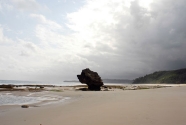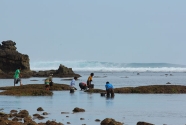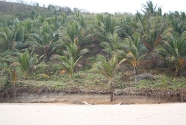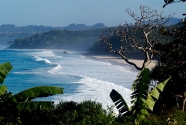
By Olaf Guerrand
For the month of September we have picked “Nihiwatu Beach”, a natural, beautiful and mostly undeveloped beach on the island of Sumba, Indonesia.
Sumba, formerly known as “Sandalwood Island”, is located southeast of the Indonesian archipelago, west of Papua; the island has an area of 11,155 square kilometer (4,306 square mile), mountains up to 1,220 meters (4,000 feet) high, approximately 200 kilometers (124 miles) long and 100 (62) wide and no volcanoes. The island’s population was officially at 611,422 as of 2005.
Discovered in the 16th century by Portuguese explorers, Sumba was incorporated into the Dutch East Indies in 1866. However, the island had very little contact with the outside world and remained, throughout history, largely “ignored” due to its lack of natural resources and fierce warriors (famous headhunters). Although, at one point the island was forested with aromatic sandalwood, before it was stripped bare by Arab, Malay, Indian and Chinese traders. The island was also known for its small and versatile horses, which were purchased by the British Royal Navy to fight its colonial wars.
Due to its insularity, Sumba has a powerful and authentic culture, which has remained largely uninfluenced by the outside world. Sumba is known for its unique hand-woven “ikat” fabric. Also, its people are one of the last great living Megalithic cultures in the world to bury prominent individuals when they die (it was current practice during the Neolithic and Bronze Age). A majority of the population is animist, the traditional religion; however, due to the influx of missionaries in recent history, many have converted to Christianity.
Unfortunately, the health situation on the island is extremely poor; a high percentage of the population suffers from malaria, malnourishment, bad hygiene and is uneducated.
The coast is mostly unspoiled, undeveloped and the island is of pristine natural beauty.
Nihiwatu Beach is located at the west end of the southern shores of the island facing the Indian Ocean. The beach has a half moon shape, with south and west exposures. At its two extremities, two reefs protect the beach from severe storms and are largely responsible for the white colored sand. The reefs are also a great source of food for the local villagers.
The first picture was taken from a hilltop and shows an overview of the beach looking west (photo Nancy Opitz).
The second picture, also looking west, shows the beach at low tide and displays a beautiful solitary rock (photo Nancy Opitz).
The third and fourth pictures show “natural” erosion, with trees and vegetation falling into the ocean, as well as the landward retreat of the shoreline. As the beach is mostly undeveloped, with the exception of the eastern end where an eco lodge named after the beach is located, this natural process is not a problem, unlike many other parts of the world where beaches are crowded with constructions built to close to the ocean. On the south shorelines of Sumba most villages were built on hilltops to protect themselves against invaders and storms.
The eco lodge at Nihiwatu co-founded The Sumba Foundation, an American foundation, which provides water wells, improved health and education initiatives to tens of thousands of Sumbanese villagers. Nihiwatu is also an international leader in the “responsible tourism” movement (For more information please see sumbafoundation.org).
The fifth picture shows local villagers fishing the eastern reef (photo Nancy Opitz).


















